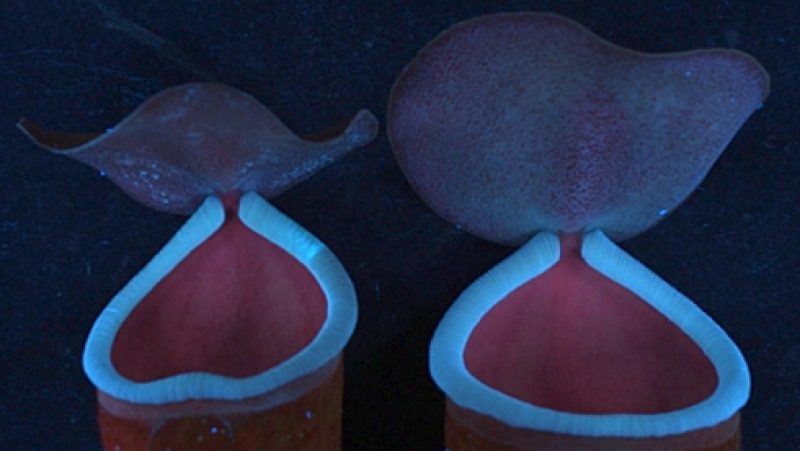
The plant kingdom is myriad and of particular fascination and interest are the carnivorous plants—plants that “eat” other living beings, mostly insects. Of the four lakh plant species in the world, about a thousand are carnivorous plants that grow in nutrient-poor soil and derive nutrition by trapping insects and other invertebrates.
Nepenthes, a group of pitcher plants also called pitcher plant or monkey cups, is a genus of carnivorous plants with nearly 160 species. They are found distributed across Madagascar, South East Asia, north Australia-New Guinea region with hotspots in Borneo, Sumatra and the Philippines. These plants have sword-like leaves that end in slender, thread-like tendrils which aid in climbing. As an evolutionary strategy to combat nutrient deficiency, the tendrils of these plants end in cup-like ‘leaf pits’ or ‘pitchers’.
“Carnivorous plants are unique life forms on Earth. They capture insects and other arthropods through several adaptations, leading to their survival”, says Dr Sabulal Baby, a researcher at the Jawaharlal Nehru Tropical Botanic Garden and Research Institute, Thiruvananthapuram. In a study published in the journal Scientific Reports, funded by the Government of Kerala and Kerala State Council for Science Technology and Environment(KSCSTE), he and his colleagues have reported that pitcher plants use cavities filled with carbon-dioxide to attract insects.
The pitchers of Nepenthes remain unopened prior to maturity and get partially filled with acidic enzymes on maturity. Pitchers also have a flap (operculum), which initially seals the growing trap, and once they mature, breaks open for prey capture. Pitchers use cues like nectar, smell, colour and light patterns (fluorescence) to attract prey. Once the insect is stung by this fatal attraction, the fluids secreted by the pitcher rush to ‘digest’ the catch and the plant devours on the unsuspecting prey.
The findings of this study add a new dimension to cues that aid in prey attraction. “This study discovered high levels of carbon-dioxide in unopened Nepenthes pitchers and constant release of carbon-dioxide from open pitchers attracting preys towards them. This is a new prey capture mechanism in the genus Nepenthes”, remarks Dr Baby about the findings.
The researchers conducted some preliminary tests in the field to discover the gas-filled pitchers and further examined the role of carbon dioxide in these pitchers. “Nepenthes pitchers are even described as ‘hollow leaves’ in the literature. However, they are not entirely ‘hollow’. Unopened N. khasiana pitchers give a gas-filled sensation when pressed with our hands, and on further forcing, they burst open mostly at the peristome-lid portion. From these field observations, we inferred that there is ‘some' gas inside the unopened Nepenthes pitchers. This observation prompted us to look into the gas composition using gas chromatography, which detected high levels of carbon dioxide", explains Dr Baby.

Fig : (a) Nepenthes khasiana pitchers in white light, (b) blue fluorescence emissions from N. khasiana pitcher peristomes in ultraviolet (UV 366 nm).
The researchers also observed that the pH level of the unopened pitchers is approximately 3.50. The acidity increases when prey is captured, turning the fluid inside to yellow from colourless. This increased acidity is due to the dissolved carbon dioxide in the pitchers, the study found. However, where does the carbon-dioxide in the pitchers come from? Microscopic images of the tendrils and roots showed the presence of numerous hollow channels or vascular bundles within them. They also ruled out the possibility of carbon-dioxide coming from the soil to the pitchers through these vascular openings in tendrils and roots. Instead, they found that enhanced respiration of the unique pitcher tissues is responsible for the high levels of carbon dioxide.
The researchers elucidate further on how carbon dioxide plays a vital role in prey capture. “Carbon dioxide is a known insect attractant. Most insects pay special attention to the ‘subtle variations’ or ‘gradients’ of carbon dioxide in the form of plumes arising from individual point sources. Insects have well developed carbon-dioxide receptors which can detect these variations as a means of locating their food. In our study, the open pitchers of N. khasiana are found to be constant emitters of carbon dioxide, which is a sensory cue that attracts prey", explains Dr Baby.
This study answers some interesting questions about the unique nature of Nepenthes and other insectivorous plants, opening avenues for in-depth studies. “We are now interested in finding the phytochemicals within Nepenthes khasiana and also interested in searching for any new prey capture mechanisms displayed by these plants”, says Dr Baby, explaining the future roadmaps for the research.





